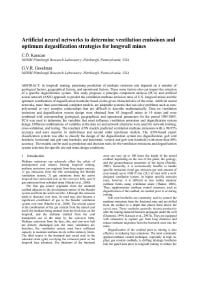Mining Publication: Artificial Neural Networks to Determine Ventilation Emissions and Optimum Degasification Strategies for Longwall Mines
Original creation date: June 2008
Authors: C� Karacan, GV Goodman
NIOSHTIC2 Number: 20034161
Proceedings of the 12th U.S./North American Mine Ventilation Symposium, Reno, Nevada, June 9-11, 2008. Wallace, Jr. KG. ed., Reno, NV: University of Nevada-Reno, 2008; :321-329
In longwall mining, premining prediction of methane emission rate depends on a number of geological factors, geographical factors, and operational factors. These same factors also can impact the selection of a specific degasification system. This study proposes a principle component analysis (PCA) and artificial neural network (ANN) approach to predict the ventilation methane emission rates of U.S. longwall mines and the optimum combination of degasification boreholes based on the given characteristics of the mine. Artificial neural networks, more than conventional computer models, are adaptable systems that can solve problems such as nonpolynomial or very complex relationships that are difficult to describe mathematically. Data on ventilation emissions and degasification system design were obtained from 63 longwall mines in 10 states and were combined with corresponding geological, geographical, and operational parameters for the period 1985-2005. PCA was used to determine the variables that most influence ventilation emissions and degasification system design. Different combinations of variables in the data set and network structures were used for network training, cross-validation, and testing. The resultant ANN models predicted ventilation methane emissions with a 90-95% accuracy and were superior to multi-linear and second order non-linear models. The ANN-based expert classification system was able to classify the design of the degasification system (no degasification, gob vent borehole, horizontal and gob vent borehole, and horizontal, vertical and gob vent borehole) with more than 80% accuracy. The models can be used as prediction and decision tools for the ventilation emissions and degasification system selection for specific site and mine-design conditions.

NIOSHTIC2 Number: 20034161
Proceedings of the 12th U.S./North American Mine Ventilation Symposium, Reno, Nevada, June 9-11, 2008. Wallace, Jr. KG. ed., Reno, NV: University of Nevada-Reno, 2008; :321-329